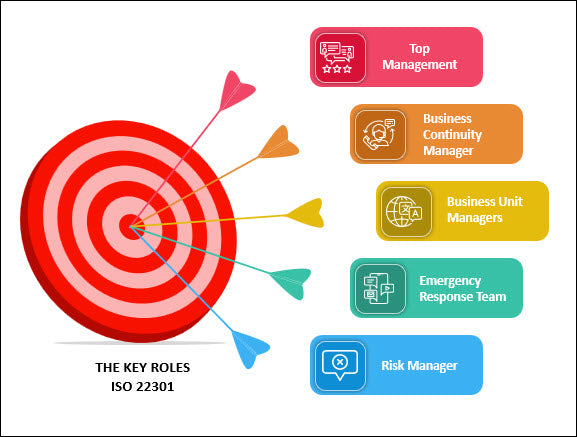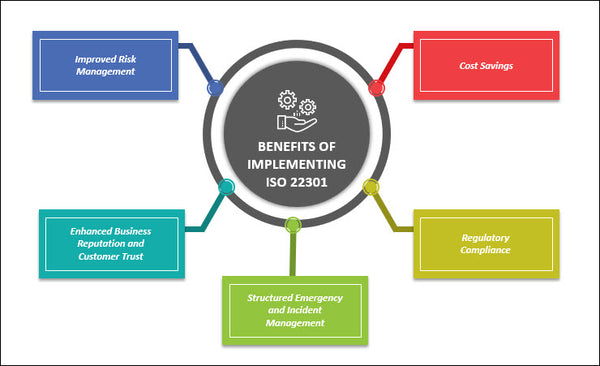ISO 22301 Business Continuity Principles
In today's fast-paced and unpredictable business environment, organizations face numerous risks that can disrupt operations and lead to significant financial losses. To mitigate these risks and ensure the resiliency of their operations, many businesses turn to ISO 22301, the international standard for business continuity management systems.

ISO 22301 provides a framework for implementing effective strategies and processes to enhance an organization's ability to withstand and recover from disruptive incidents. This blog post will explore the fundamental principles of ISO 22301 and their importance in building a robust business continuity management system. This article will provide valuable insights and guidance, whether new to the standard or looking to enhance your existing practices.
Understanding the Importance of Business Continuity
Ensuring business continuity is crucial for organizations in today's rapidly changing and unpredictable business landscape. Disruptions can occur from natural disasters, cyber-attacks, supply chain interruptions, and many other sources. The consequences of these disruptions can be significant, including financial losses, damage to reputation, and even the closure of the business.
ISO 22301 is vital in helping organizations address these risks and build resilience. By implementing the principles outlined in the standard, businesses can minimize the impact of disruptions and quickly recover their operations.
One of the fundamental principles of ISO 22301 is understanding the importance of business continuity. This involves recognizing the potential risks and consequences they may have on the organization. Organizations can identify critical functions, prioritize resources, and build resilience by conducting a thorough risk assessment and developing a comprehensive business continuity plan.
The following section will delve deeper into risk assessment and business impact analysis and how they contribute to building a robust business continuity management system according to ISO 22301. Stay tuned!
The Key Roles in ISO 22301
In ISO 22301, several key roles are crucial in successfully implementing and operating a Business Continuity Management System (BCMS). These roles ensure that the necessary actions are taken to protect the organization from disruptions and preserve its ability to function.
1. Top Management: The leadership team drives the BCMS implementation and ensures its effectiveness. They provide the necessary resources, commitment, and support to establish a culture of resilience within the organization.
2. Business Continuity Manager: This individual oversees the development, implementation, and maintenance of the BCMS. They coordinate with all departments to ensure that plans are in place, monitored, and tested regularly.
3. Business Unit Managers: Each department has a Business Unit Manager responsible for implementing and maintaining business continuity plans within their respective areas. They work closely with the Business Continuity Manager to ensure alignment with overall organizational objectives.
4. Emergency Response Team: This team is responsible for immediate response and actions during an incident, such as evacuation, communication, and damage assessment. They are trained to handle emergencies and ensure the safety of employees, customers, and assets.
5. Risk Manager: This role is responsible for assessing risk, identifying potential threats, and implementing risk management strategies. They work closely with other roles to develop effective business continuity strategies.
In collaboration with other stakeholders, these key roles provide a clear framework for establishing and implementing roles and responsibilities within your organization's BCMS. Understanding their functions and responsibilities is essential to ensure a coordinated and effective response to incidents, minimizing the impact on your organization's operations.
Establishing a Business Continuity Management System
Building a robust Business Continuity Management System (BCMS) is essential for organizations seeking to ensure their continued operations in the face of disruptions. ISO 22301 provides a framework for establishing a BCMS that aligns with internationally recognized best practices.
To begin, organizations must define their scope and objectives. This involves identifying the key processes, functions, and resources that must be protected and ensuring that the BCMS aligns with the organization's goals. By clearly defining the scope, organizations can focus on areas most critical to their operations.
Next, organizations must conduct a thorough risk assessment and business impact analysis. This involves identifying potential threats and vulnerabilities, assessing their likelihood and impact, and prioritizing them based on their potential consequences. By understanding the risks and their potential impact, organizations can develop effective strategies to mitigate them.
Once the risks have been identified, organizations must develop and implement risk treatment measures. This includes defining strategies for prevention, mitigation, response, and recovery. Organizations can effectively address potential disruptions and minimize their impact by having a well-defined and comprehensive set of risk treatment measures.
Finally, organizations must regularly monitor and evaluate the effectiveness of their BCMS. This includes conducting regular audits, reviews, and tests to ensure the BCMS remains up-to-date and aligned with the organization's changing needs and capabilities. By continuously monitoring and evaluating the BCMS, organizations can identify areas for improvement and take proactive measures to enhance their resilience.
In the next section, we will discuss the importance of employee awareness and training in ensuring the successful implementation of a BCMS according to ISO 22301. Stay tuned to learn how organizations can engage employees and build a business continuity culture.
Conducting Business Impact Analysis and Risk Assessment
Once the scope and objectives of the Business Continuity Management System (BCMS) have been defined, organizations need to conduct a thorough business impact analysis and risk assessment. This step is crucial in identifying potential threats and vulnerabilities that could disrupt business operations.
The business impact analysis involves assessing the potential consequences of various disruptions on critical processes, functions, and resources. This analysis helps organizations prioritize their efforts and allocate resources effectively. By understanding the impact of different scenarios, organizations can develop targeted strategies to mitigate and minimize the risks.
Organizations must also conduct a risk assessment to complement the business impact analysis. This involves identifying potential threats, determining their likelihood and impact, and prioritizing them accordingly. Organizations can make informed decisions on the appropriate risk treatment measures to implement by assessing the risks.
During the risk assessment, organizations should consider various potential threats, including natural disasters, cyberattacks, supply chain disruptions, and regulatory non-compliance. By considering a comprehensive range of risks, organizations can develop a resilient BCMS that addresses the most critical threats facing their operations.

Benefits of Implementing ISO 22301 Business Continuity Principles
Implementing ISO 22301 Business Continuity Principles can provide numerous benefits to organizations. By following these principles, organizations can enhance their ability to manage disruptions effectively, improve business resilience, and ensure continuity of critical operations.
Improved Risk Management:
- Identify threats and vulnerabilities through comprehensive analysis.
- Develop targeted strategies to mitigate risks.
- Minimize disruption likelihood and impact, enhancing risk management.
Enhanced Business Reputation and Customer Trust:
- Demonstrate commitment to uninterrupted services, even during disruptions.
- Build confidence among customers, suppliers, and stakeholders.
- Strengthen organizational reputation.
Structured Emergency and Incident Management:
- Prompt and effective response during disruptions.
- Minimize negative consequences on critical operations.
- Predefined emergency response plans reduce downtime and enhance service delivery.
Regulatory Compliance:
- Align with globally recognized ISO 22301 standard.
- Demonstrate compliance with industry and jurisdiction-specific requirements.
- Mitigate legal and financial risks.
Cost Savings:
- Proactive risk identification and mitigation avoid costly disruptions.
- Optimize resource allocation.
- Reduce insurance premiums and improve operational efficiency.
In summary, implementing ISO 22301 Business Continuity Principles offers benefits such as improved risk management, enhanced reputation, effective emergency response, compliance, and cost savings, ensuring continuity of critical operations and long-term resilience.
Conclusion
In conclusion, implementing ISO 22301 Business Continuity Principles is essential for organizations that want to enhance their resilience, minimize disruptions, and ensure the continuity of critical operations. By following these principles, organizations can improve their risk management capabilities by identifying and mitigating potential threats. This proactive approach helps organizations optimize resource allocation and reduce costly downtime.
Additionally, adhering to ISO 22301 helps organizations maintain customer trust and build a strong reputation by demonstrating their commitment to uninterrupted services and products, even in disruptions. Organizations can also benefit from having a structured framework for managing emergencies, crises, and incidents, allowing them to respond promptly and effectively.
Furthermore, ISO 22301 facilitates regulatory compliance, ensuring organizations meet industry-specific requirements and mitigating potential legal and financial risks. Lastly, implementing ISO 22301 can lead to cost savings in the long run by proactively avoiding disruptions and optimizing operational efficiency.
By adopting ISO 22301 Business Continuity Principles, organizations can create a robust foundation for business resilience, secure customer trust, and achieve long-term success.

